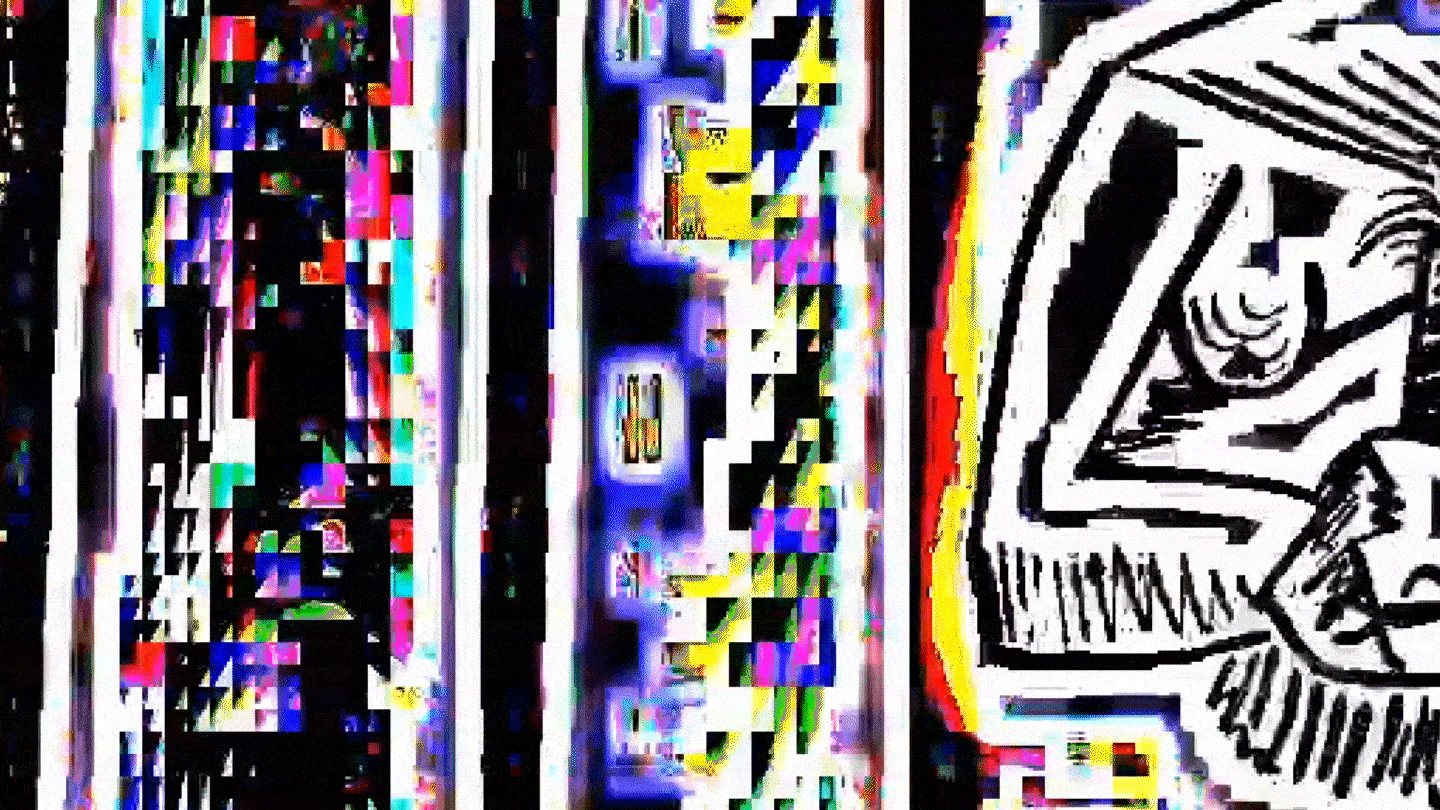
What must a work of art do to make us feel something when we’ve been anesthetized by 10-second videos, marketing emails, and endless images of suffering? It can feel as though you need special training to understand a painting. Which forms best speak to a broad public? There’s a lot of money on immersive experiences as the answer to both questions. And there are plenty of spectacles these days that pander to shortened attention spans, surrounding us with motion and color, while staging great backdrops for selfies. But after viewers are wowed, then what? In recent exhibitions, Mark Leckey and Cory Arcangel have each tweaked the techniques of immersion to get at the essence of awe.
Since the late '90s, Leckey has made work that reaches beyond the rarified codes of art discourse, investigating class and memory through raves, amusement parks, and vernacular forms. In his show “3 Songs from the Liver,” now on view at Gladstone Gallery in New York, the British multimedia artist presents a sequence of video installations made since 2021, using timing, lighting, and other tricks from the arsenal of immersive experiences to guide the viewer’s attention.
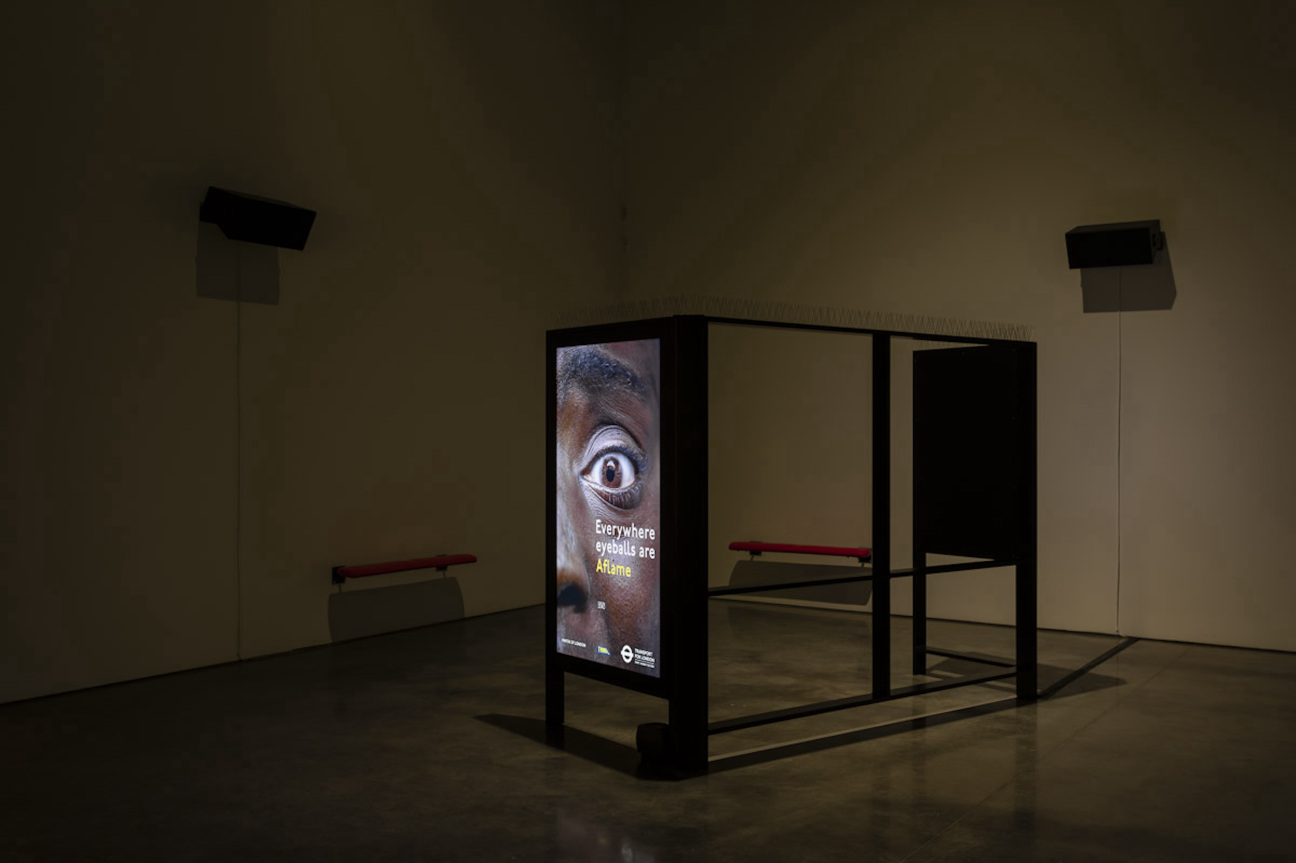
The first “song” (actually a hybrid video-sculpture) in Leckey’s trio is To the Old World (Thank You for the Use of Your Body), 2021. The work begins with a clip, which Leckey found online, of a man hurling himself against a bus-stop shelter, shattering the glass and falling into a pile of shards. The alarming action repeats again and again, playing on a LED screen mounted in a bus shelter-like armature. It’s followed by a digital animation that gives us a perspective that the phone footage can’t—the man’s face from the other side of the glass, his searching gaze in the moments just before and after impact. At the piece’s end, big eyes fill the screen, and Leckey uses them as a motif in pseudo-Biblical reworkings of public safety ads: Instead of “If you see something, say something,” the artist gives us, “If I eye anything, it shall be invisible.”
The germ of the second piece, Carry Me Into the Wilderness, 2022, is a video Leckey shot when he was overcome by emotion, walking through London’s Alexandra Palace park. We can only see green and gray blurs in his phone footage, but he tries to summon his surprise experience of the sublime with digital models and animations of a holy’s hermit’s cave, taken from a medieval painting of Saint Anthony. Sparkling and pulsing in its simulated 3-D environment, the cave mirrors Leckey’s urgency as he moans, “I can’t bear it.” Looming behind is a silhouette of a castle, the details of which are fleshed out in a wall-spanning rendering in the final video, Mercy I Cry City, 2024. You can’t see the whole castle at once; it's behind another wall. You can only glimpse parts of it through rectangular apertures as it moves, spins, and finally, vanishes in a golden glow.
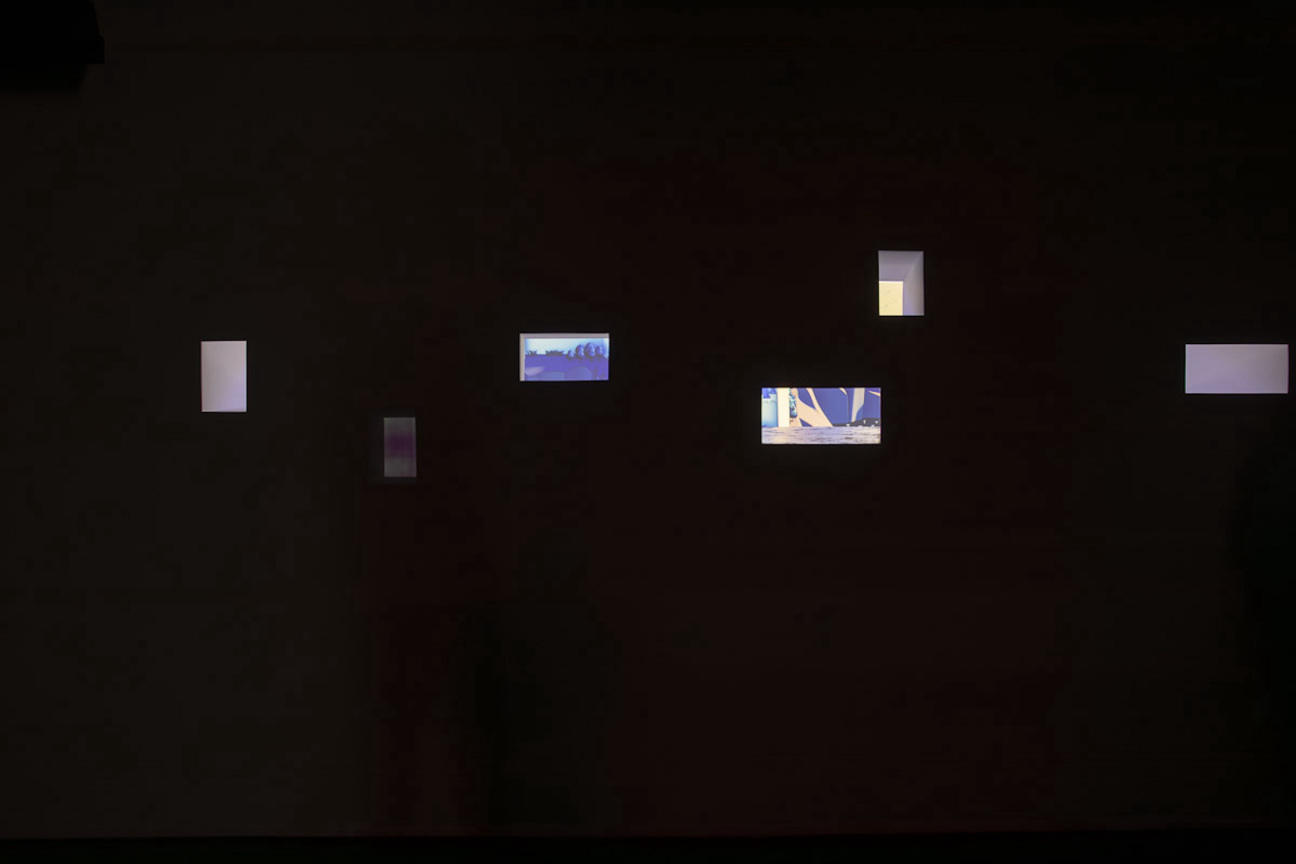
A few paintings, gilded like Byzantine icons, are installed around the gallery—one depicts Saint Anthony’s cave, another, a figure tumbling mid-air, like the bus-stop guy. In a statement accompanying the exhibition, Leckey writes that the icon functions as a portal to the divine or "disembodied realms," rather than as a mere image. Notably, an icon doesn’t replicate our vantage; it merges multiple viewpoints, including—in the ancient immersive technique of reverse perspective—that of a saint, or of God: He is regarding you. Contemporary immersive experiences trade in other modes of reversal and meld. As crowds pass through the interactive rooms designed by the technologists of teamLab, or the sandbox sculptures of Meow Wolf, dotted with worldbuilding easter eggs, attention is refracted, engaged by many objects at once. These experiences encourage visitors to take ritual selfies, and to transmit their perspectives across social media. It would be hard to take a decent selfie in the dimness of “3 Songs from the Liver.”
Leckey keeps attention trained on the work and perhaps—via its spooky, staring eyes—the work’s attention is trained on you, the viewer, in an intimate, iconlike circuit of marvel. Taken separately, the elements of this show might seem corny: the meme-page stunt, the overwrought epiphany, the cartoon castle, and the theatrical spotlights in the darkened gallery. But Leckey’s raw, insistent quests for spiritual transcendence add up to something profound.
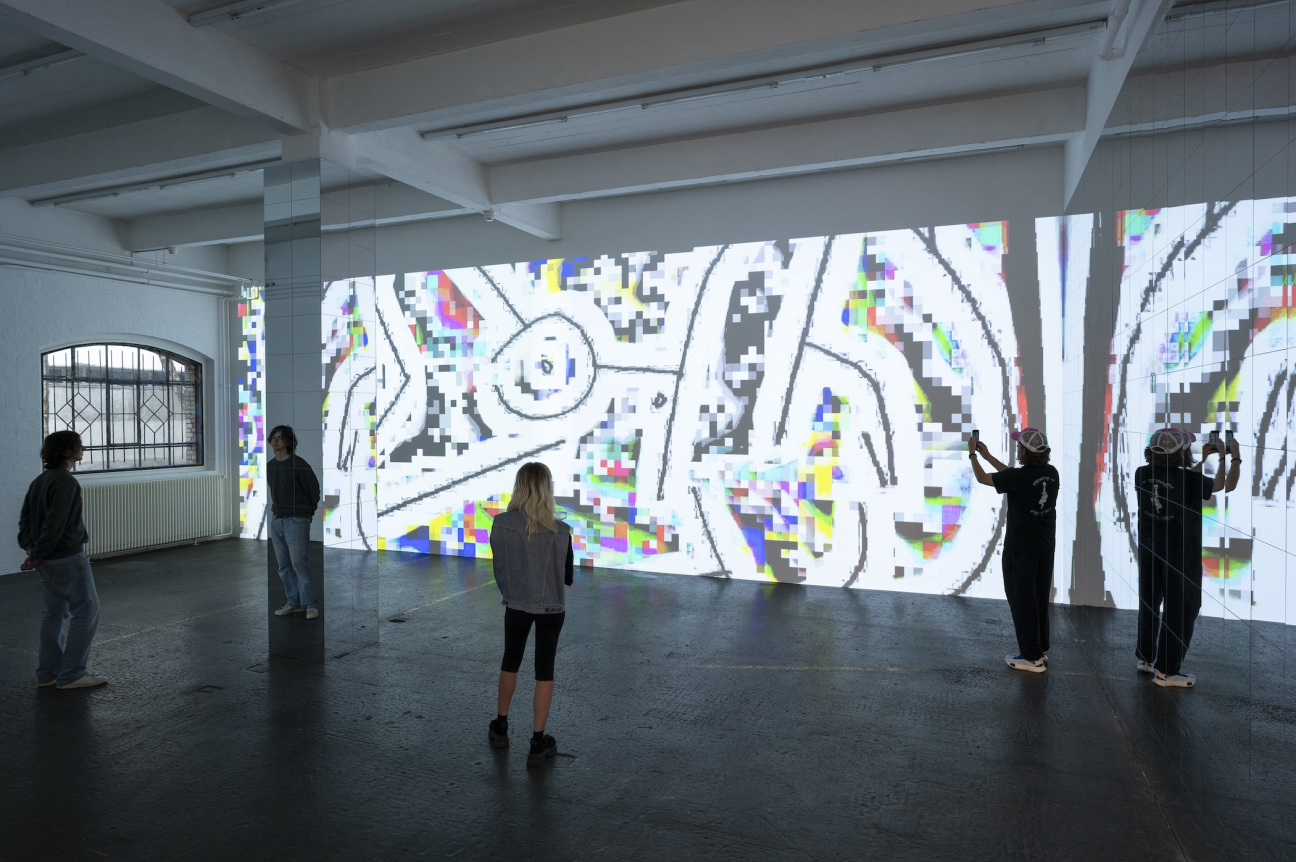
Another kind of immersive experience, as you’ve surely heard, involves large-scale projections of paintings by famous artists—Van Gogh, Monet, Klimt. In these settings, viewers aren’t expected to do much besides stand and stare at walls full of digitized art. The American artist Cory Arcangel, referencing the phenomenon, presented an immersive Picasso installation at the exhibition “<<ALL I EAT IN A DAY>>,” which he co-curated with Giovanni Carmine for Kunst Halle Sankt Gallen in Switzerland this past fall. For Femmes d’Alger dans leur appartement (Version A), 2024, based on Picasso’s “Women of Algiers” series, Arcangel filmed himself flipping through the pages of a catalogue of reproductions, then ran the footage through software he developed with Henry Van Dusen. The program compressed and fried the material, reorganizing its colors into chunky, flickering pixels. (The immersive Van Gogh exhibit I saw also digitally altered the artist’s work—impasto brushwork squiggles like nests of worms.) Projected on a long wall of the Kunsthalle and reflected in mirrors, Arcangel’s video was gorgeous and impressive even as it poked fun at the use of similar immersive effects elsewhere.
The work reminds us of what, in other artist-branded experiences, we take for granted: that they show us reproductions, digitally manipulated. Photographs of paintings were once considered aura-less inferiors, but in our mediated moment they’ve almost gained the status of primary sources. Experiences like Immersive Van Gogh draw big crowds even in New York, where people can buy a cheaper ticket to see the originals in a museum. Arcangel’s insight is that it’s the mode of circulation that now holds our attention—and it’s worthy of experiencing on a grand scale. With the magic of such re-mediation in mind, he invites us to look at him looking at reproductions of Picassos. (“Women of Algiers,” not incidentally, is a series the painter made about his experience of looking at Delacroix; his 15 versions rework a titillating Orientalist painting that peeks inside a women’s bathhouse.) It’s funny, but as with most of Arcangel’s work, there’s an earnestness behind the smirk. Art is beautiful; Picasso is great; paging through a sumptuous catalogue is a rewarding aesthetic experience. Why not make an extravaganza of it?
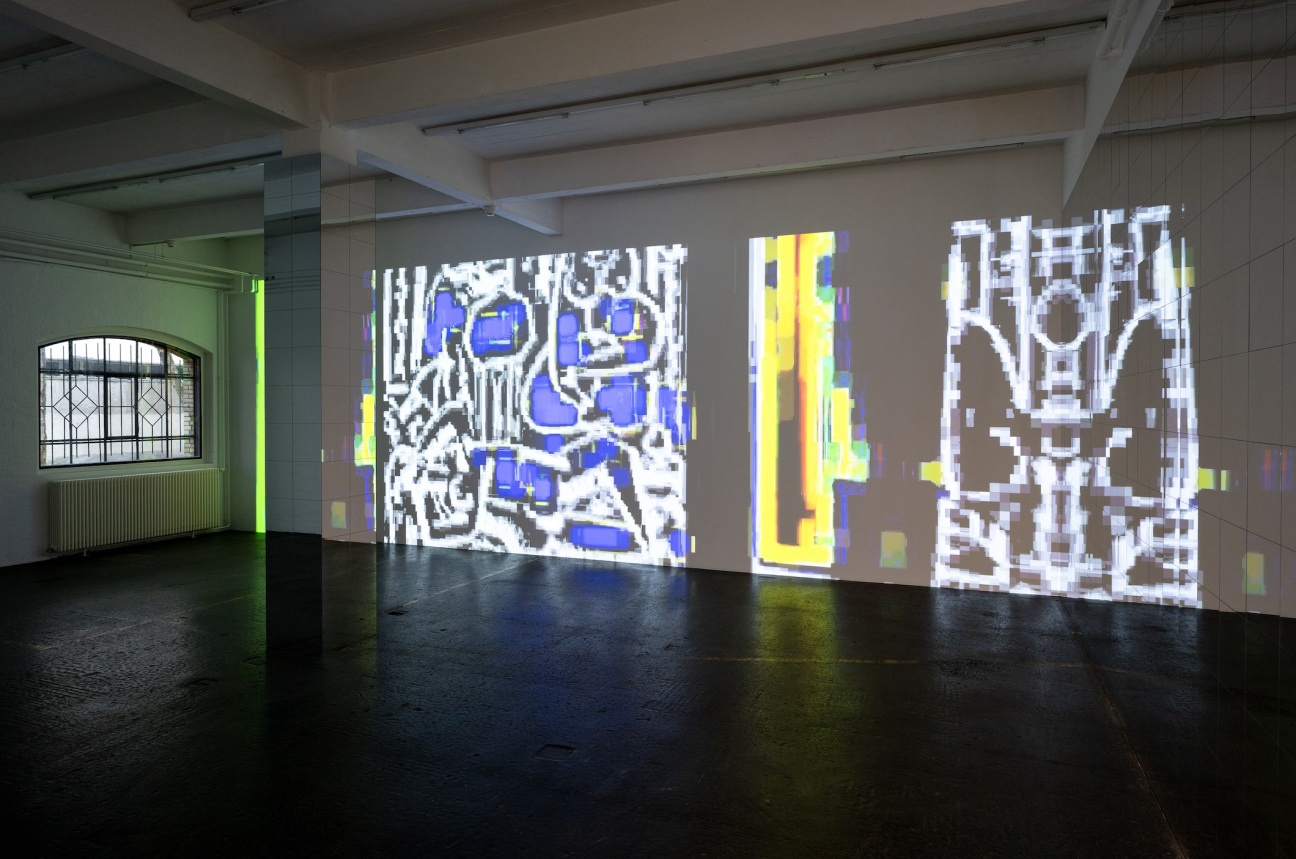
“<<ALL I EAT IN A DAY>>” was about the afterlives of art in today’s cultural economy, with works exploring how its traditional mystique is leeched by brand activations—TV shows, NFT collections, generative A.I., and merch. The immersive experience industry extracts branding from art and its institutions (the Van Gogh in Immersive Van Gogh, the museum in the Museum of Ice Cream). Leckey and Arcangel—both curious about the pleasures of vernacular forms and pop culture, and how they mesh with the cerebral and aesthetic concerns of contemporary art—reject mechanisms of extraction and embrace dynamics of exchange. Neither wants to simply engineer a situation of visual overwhelm. They’re concerned with the workings of the mediums used to create it—digital projections, animation, architecture, and spatial tricks. Art’s promise is to move us. Leckey and Arcangel, with their searching practices and innovative installations, are analyzing the thrills of art-adjacent entertainment to find new ways of making good on that promise.
Brian Droitcour is a critic and curator specializing in digital art.










 in your life?
in your life?

